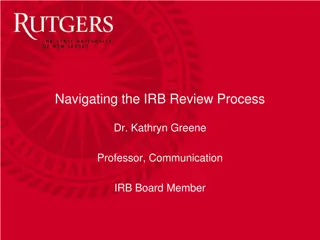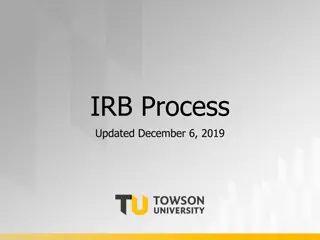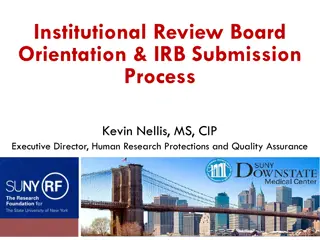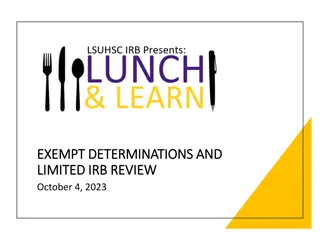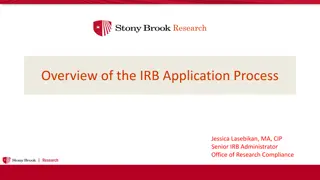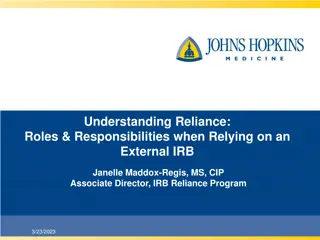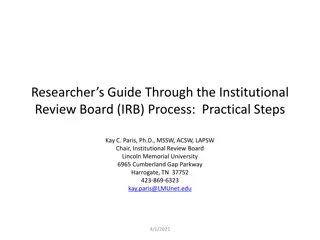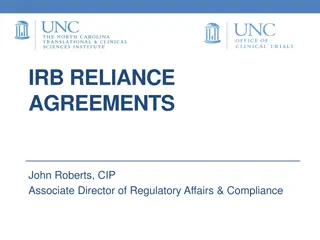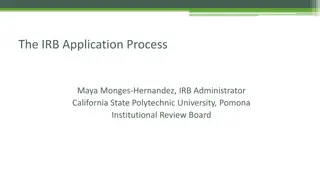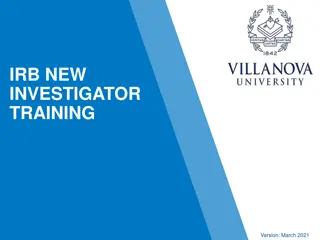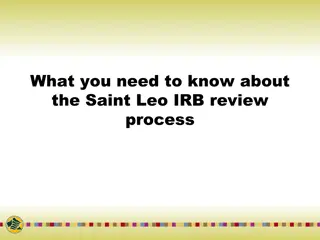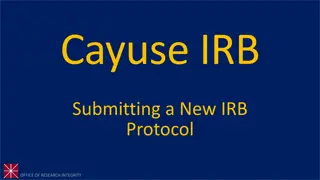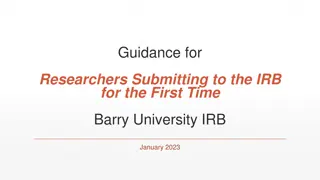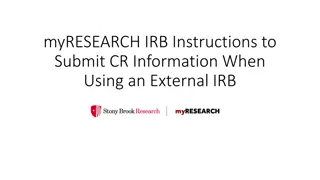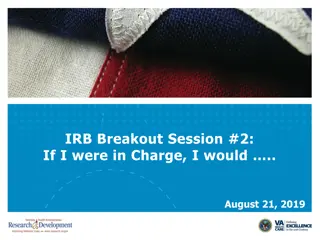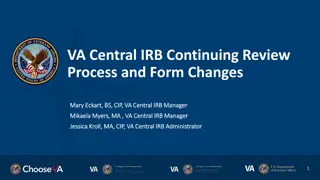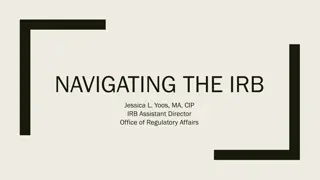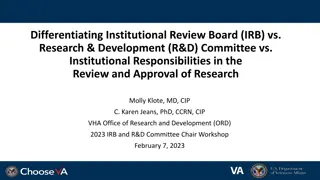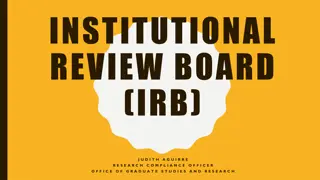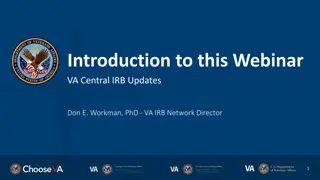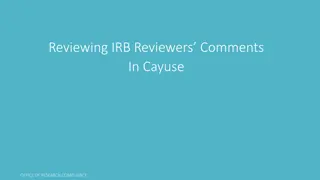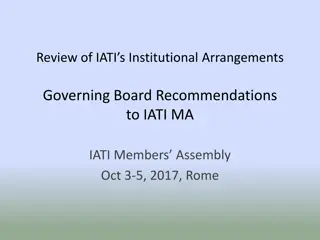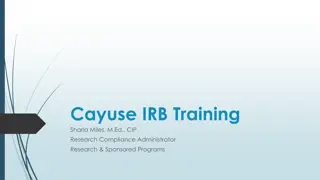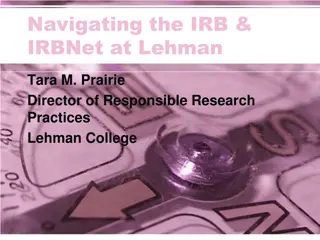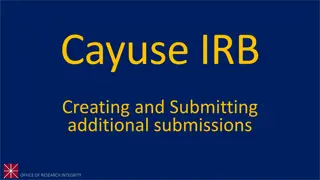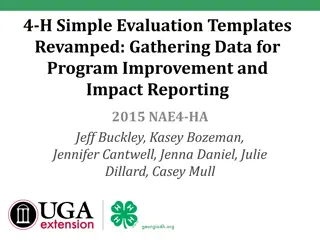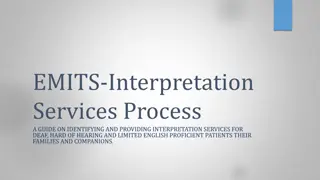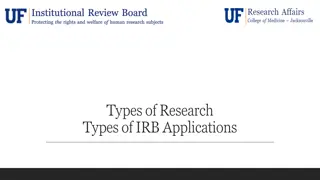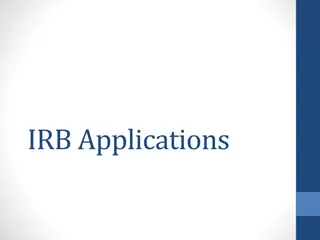Introduction to Institutional Review Board (IRB): Overview and Application Process
This detailed content provides an introduction and overview of the Institutional Review Board (IRB), covering its history, purpose, application process, and available resources. The IRB ensures that research involving humans adheres to ethical principles and regulatory requirements to protect participants' rights and welfare.
Download Presentation

Please find below an Image/Link to download the presentation.
The content on the website is provided AS IS for your information and personal use only. It may not be sold, licensed, or shared on other websites without obtaining consent from the author. Download presentation by click this link. If you encounter any issues during the download, it is possible that the publisher has removed the file from their server.
E N D
Presentation Transcript
Introduction and Overview to the Introduction and Overview to the Institutional Review Board (IRB) Institutional Review Board (IRB) SiDi Lab Meeting 10.20.23 John Z. Clay
IRB History IRB History Aftermath National Research Act (1974) An Act to amend the Public Health Service Act to establish a program of National Research Service Awards to assure the continued excellence of biomedical and behavioral research and to provide for the protection of human subjects involved in biomedical and behavioral researchand for other purposes. Belmont Report (1978) Unifying ethical principles Respect for persons: protecting the autonomy of all people and treating them with courtesy and respect and allowing for informed consent. Researchers must be truthful and conduct no deception (integrity); Beneficence: the philosophy of "Do no harm" while maximizing benefits for the research project and minimizing risks to the research subjects; and Justice: ensuring reasonable, non-exploitative, and well-considered procedures are administered fairly the fair distribution of costs and benefits to potential research participants and equally. IRB Purpose The purpose of an Institutional Review Board (IRB) is to ensure research involving humans applies ethical principles and complies with federal regulatory requirementsfor protecting the rights and welfare of human participants.
IRB Application IRB Application Submitting an IRB Proposal Step 1: Determining type of study Full Board Review Potential risk to participants Expedited Minimal risk; usually clinical trials Exempt No risk; usually educational or psychological Step 2: a. Creating the proposal; b. and everything else Mastermind your entire research study Step 3: Creating the Informed Consent Form Step 4: Upload & submit all documents in the Research Management Suite (UTRMS) Step 5: Iterate / address IRB issues Extra things to consider External Personnel Form Reliance Agreements Modifications Scary stuff!
IRB Resources IRB Resources UT IRB templates - https://research.utexas.edu/ors/human-subjects/submitting-to-irb/irb-submission-forms/ UT Research Management Suite - https://research.utexas.edu/ors/human-subjects/submitting-to-irb/ UT IRB Chat - https://research.utexas.edu/ors/human-subjects/get-help/ CITI training - https://research.utexas.edu/ors/human-subjects/for-researchers/training/instructions-for-registering- for-human-subjects-research-training/ External Personnel Form - If a study includes researchers from other institutions AND there is no reliance agreement, each external collaborator will need to be entered into the UT system. The three items to consider are: 1. All external researchers are required to obtain a UTEID. 2. External researchers need to have completed CITI training certificates that are recognized by UT. This last point is important, because CITI training modules differ slightly between universities. Some universities are stricter and require CITI trainings that cover more information. UT's IRB is very strict and may not accept CITI trainings from another institution. My process has been to provide the CITI certificates that external researchers acquired from their institution, and the UT IRB will tell you if they do not accept it. In that case, the external researcher will have to follow the instructions to complete the UT recognized training. 3. Lastly, all external researchers will have to complete a short Financial Interest Form to certify that there are no conflicts of interest. Conflict of interest form (for external researchers) - https://utexas.qualtrics.com/jfe/form/SV_5vczI7DfuxKEnSm Creating a UTEID (for external researchers) - https://idmanager.its.utexas.edu/eid_self_help/?createEID&qwicap-page-id=B38E932C6655DC6D



